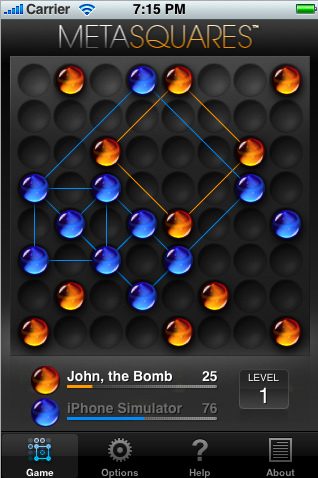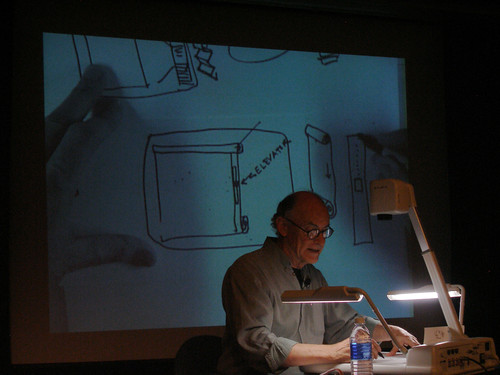Handouts available at_ Creating Career Paths for UX Professionals
Category: HCI Design
Human Computer Interaction Design
Impress Task Pain
Each and every time I open an Impress window I have to close the task pane. No, I don’t want it. I don’t need it. It just consumes screen space. If I need it I want to be in control and open it myself and close it afterwards when no longer needed.
RFE: The state of the task pane should become a persistent Impress setting.
ISSUE# 95600
C. /IBM says: Indeed, this has annoyed me for years already; in search of the hidden option to turn off this “feature”, I came across your post. Thanks for raising this!
Xing’s brokn buttons
Firefox 2 on Windows, default font size – ok: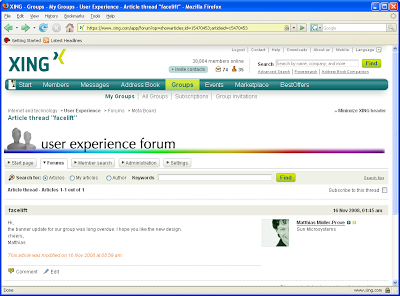
Firefox 2 on Windows, increased font size — the Find buttons show some strange artifacts:
Firefox 2 on Mac, default font size – ok: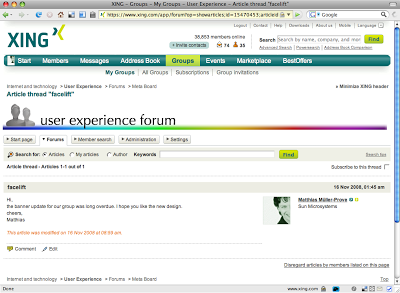
Firefox 2 on Mac, increased font size — the Find buttons show the same strange artifacts as on Windows: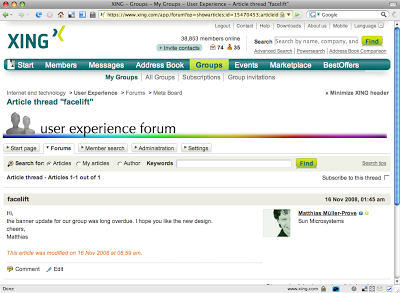
Firefox 2 on Mac, incredible increased font size — aha! This is how the UI is implemented. And I suppose Xing can also do better regarding accessibility: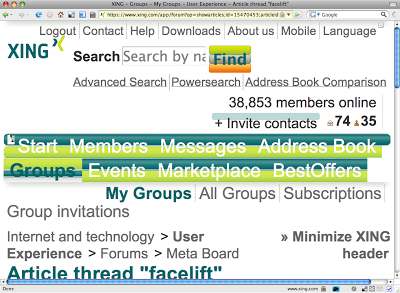
MetaSquares is back
MetaSquares, the smart and addictive game by Scott Kim is back — for iPhone, for MacOS X (soon), and a tryout verison for the web.
Bill Verplank sketches metaphors
_That was quite a remarkable evening, Bill Verplank presenting at BayCHI on Sketching Metaphors. First of all his presentation style. He had an overhead camera connected to the projector in a way that the audience could follow all his actions on the desktop. This gave him the flexibility to simply point to images in a book, show his note cards, or develop (and explain on the way) something entirely from scratch. For example on the image above Bill describes the origin of the window scrollbar and the dead metaphor of an elevator for the thumb control in the bar to the right [metaphors in italics 😉 ]
In a closing section he provided an enlightening diagram on various computer paradigms.
The computer as a tool you can use, the computer as media for information sharing and communicating with each other, and the computer as an intelligent person to interact with. If you go a step further the tools become vehicles, media becomes fashion (take Apple’s iPod as an fashion statement for example), and person becomes life – and ecosystem of self organizing systems.
Thank you Bill, for this framework of computer paradigms.
From Business to Buttons 2008 – Videos
videos and slides of the conference From Business To Buttons 2008 in Malmö/Sweden are now available. Don’t miss Don Norman’s presentation. But I am sure that there are more talks of interest.
more conference webcasts here…
Frieder Nake über Software-Ergonomie
Software-Ergonomie geht entweder im Design auf oder sie geht unter.
On Being Human in a Digital Age
Reconstruction of Bill Buxton’s closing keynote at CHI 2008:
9:1 ratio of bad ideas to good
I tell my clients that I try to maintain a 9:1 ratio of bad ideas to good. And, no, I can’t tell which are which. If only.
Handbook of Usability Testing, 2nd ed.
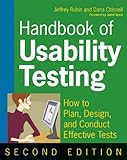
From Dana:
Hi!
I’m tingling, I’m so excited. I like to think that this is a special event in the user experience world. But every book author probably thinks that.
Handbook of Usability Testing, Second Edition by Jeff Rubin and Dana Chisnell ships on Monday, April 28.
This is not your mother’s HUT. Well, of course not. The first edition was published in 1994. Technology isn’t special anymore, it’s everywhere. (There were DOS examples, for heaven’s sake!) For HUT 2.0, Jeff and I
- Simplified the organization of the main sections
- Reordered many chapters to more closely reflect the flow of planning and conducting a test
- Updated dozens and dozens of examples, samples, and stories
- Expanded and updated discussions about recruiting participants, whether you need a lab, working with observers, analyzing testing data, and (we think) the best way to make recommendations
- Added a chapter on variations on the basic method
- Populated www.wiley.com/go/usabilitytesting with
- electronic versions of many of the deliverables used as examples used in the book
- updated references
- a (we hope) comprehensive list of other resources such as conferences and seminars, other books, blogs, and podcasts.
The drawings and diagrams are have been freshened and improved. The layout and format promise to be less nerdy and more accessible, too.
Oh, and we benefited from sage reviews from Janice James, founder of the Usability Professionals’ Association as our technical editor (brava!), and a foreword by Jared Spool. […]
Hope your experience with HUT 2.0 is good.
P.S. Here’s the official cite:
Rubin and Chisnell, Handbook of Usability Testing, Second Edition: How to Plan, Design, and Conduct Effective Tests (Wiley, 0470185481, 450 pages, April 28, 2008).
Dana’s blog: usabilitytestinghowto.blogspot.com
